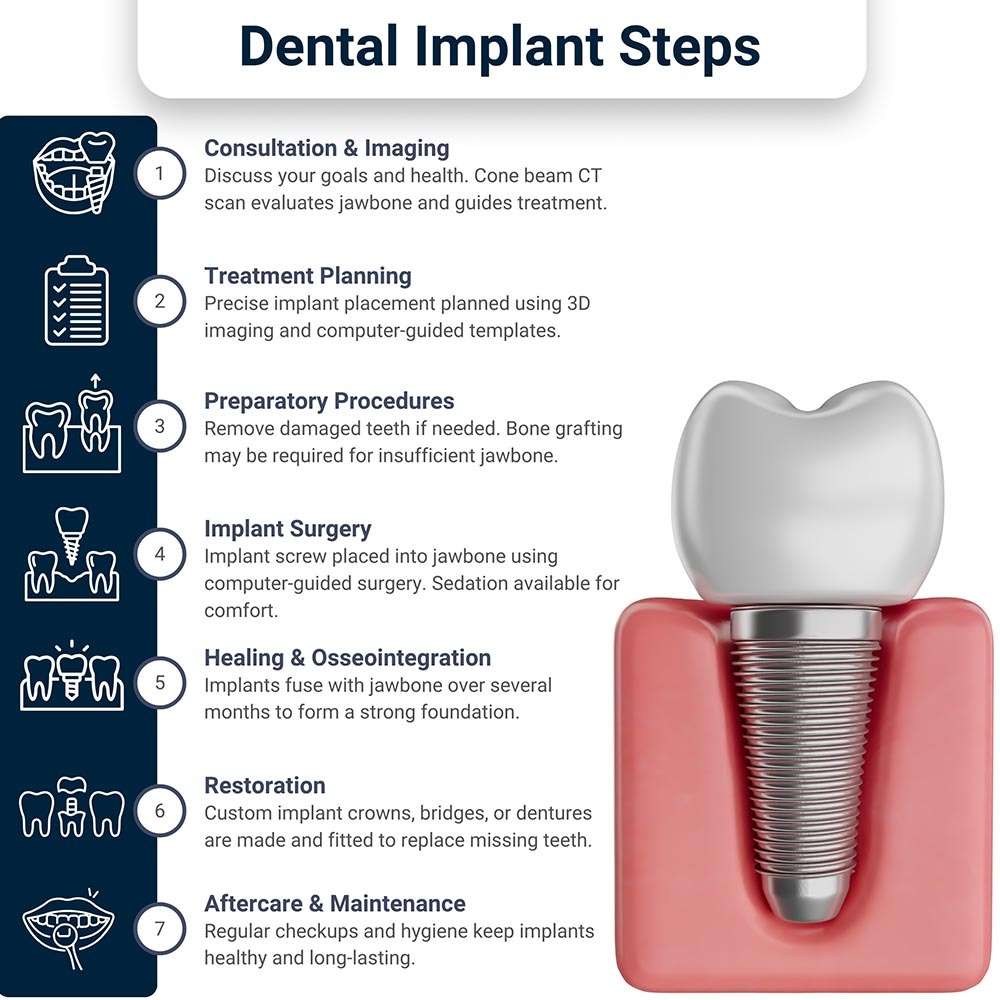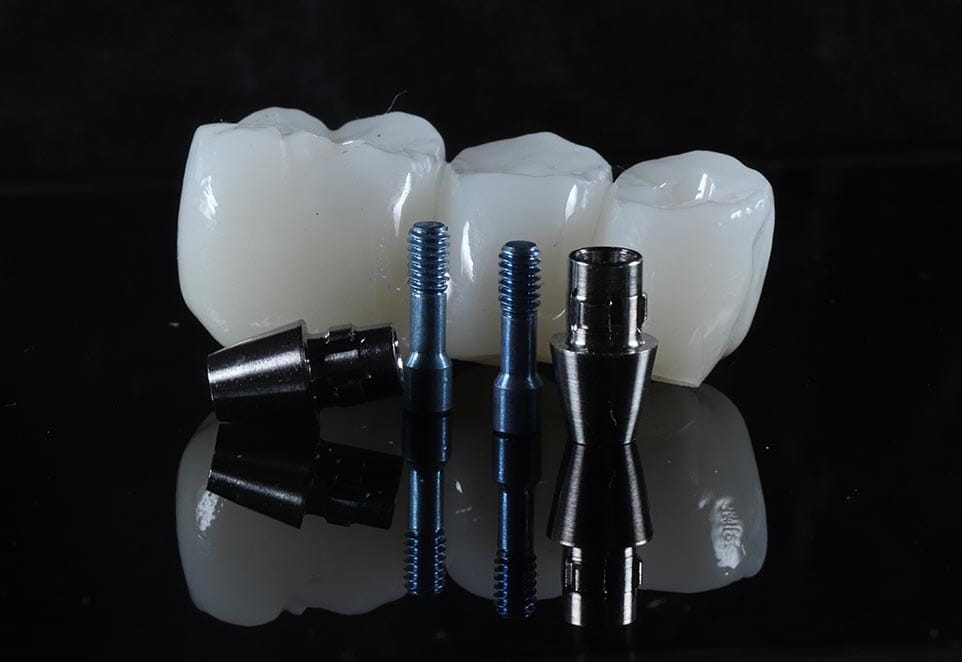Dental implants can resolve tooth loss problems, giving you teeth that look beautiful, strong, and fully functional.
If you have been thinking about dental implants, you probably have questions about what to expect, and this article can help. We explain how dental implants work, when to consider them, and provide an overview of the implant process, including recovery after surgery.
What Are Dental Implants?
Dental implants are designed to artificially replace teeth using a small screw made from medical-grade titanium or zirconium. The implant screw is surgically inserted into the jawbone and needs time to heal and integrate, gradually becoming fused firmly in place. This process is called Osseo integration.
Once the implant is fused in the jawbone, a process that can take up to 6 months, an implant abutment is fitted onto the screw. The implant abutment sticks up above the gumline, and many types are available, depending on the final restoration.
A dental implant can be restored with an implant crown that is screwed onto the implant. Two or more dental implants can support an implant bridge that is also screwed in place, replacing multiple teeth or even a complete arch. Another option is removable; an implant denture snaps onto the implants but can be snapped out for cleaning.
Why Consider Dental Implants?
Several reasons for considering this treatment are outlined below.
- Dental implant teeth are strong, long-lasting, and can be fabricated from the latest and most attractive ceramic materials.
- Most people will consider implants because they want to improve the appearance of their teeth and to have teeth that function fully without any discomfort.
- When you lose natural teeth, your jawbone soon resorbs and begins to deteriorate. Jawbone deterioration can also occur if you have advanced periodontal disease. Losing jawbone can affect your facial dimensions, destabilising any remaining teeth and making it harder to retain removable dentures. Dental implants can help prevent further jawbone loss.
- Because they act like natural tooth roots, implants stimulate the surrounding bone, helping to prevent jawbone resorption. Dental implants are the only solution for tooth loss that can provide this important benefit.
- If you have some natural teeth remaining, dental implants will help protect them. They are self-supporting, so your implant dentist will not need to reshape existing teeth, which is the case if you have a tooth-supported bridge. Dental implant teeth help share the load of biting and chewing food and ensure your remaining natural teeth stay in the right positions, helping to protect your bite.
- Dental implant treatment is versatile, with numerous options available. You can choose from fixed or removable solutions depending on your lifestyle, preference, and budget.
Understanding the Implant Process
The implant process is outlined below.

Dental Implant Consultation
An initial dental implant consultation will soon determine if implants are the right solution. During this appointment, your implant dentist will discuss your aims and desires for treatment and review your dental and medical health. They will want to take diagnostic images, including a cone beam CT scan.
The cone beam CT scan is important because it helps your implant dentist evaluate the condition of your jawbone and any existing teeth. It is used to determine the right treatment path and assess if you have enough jawbone for implants, require additional procedures like bone grafting, or have existing teeth that must be removed.
After evaluating your diagnostic images, your implant dentist can discuss possible treatment plans with you. Your choice may depend on the number of teeth requiring replacement, your preference for fixed or removable options, and your budget.
Don’t forget to ask about sedation dentistry if you feel anxious or nervous about implant treatment. Your dental implant dentist will almost certainly suggest dental sedation if you require multiple dental implants. Many dental sedatives contain an amnesiac, so that after treatment, it can feel as if a matter of minutes have passed, and you will likely remember little or nothing about the procedure.
Dental Implant Planning
Once you decide on a treatment plan, the procedure is planned behind the scenes using your diagnostic images. At this stage, your implant dentist decides where to place each implant, ensuring it will be in plenty of healthy, strong bone.
The cone beam CT scan can be manipulated to show how the implants will look and function once restored. This is important, as without proper planning, a poorly situated implant could lead to a compromise between function and appearance.
When the procedure is finalized, a computer-generated stent is created. It is a template that will fit over your gums during surgery, guiding your implant dentist so the plan is replicated exactly. Using computer-guided surgery ensures that treatment is precise, smoother, and quicker and that healing can be faster since smaller incisions are needed.
Tooth Extractions and Bone Grafting
The exact treatment plan prescribed for you will depend on whether you need other procedures like tooth extractions or bone grafting. Sometimes, these can be carried out simultaneously with implant placement. Other times, they may be standalone appointments, and you could need time to heal afterward before implant surgery.
Dental Implant Surgery
Your implant dentist will advise you on preparing for implant surgery, including when you can last eat and drink before treatment and if there is any need to discontinue any medications. When you arrive, any dental sedation required will be given before your mouth is numbed.
Your dental implants will be inserted using computer-guided surgery. Once in your jaw, your dentist may attach temporary teeth straightaway or cover the implants and leave them to heal. Even if the implants are covered, you can still have temporary teeth to use during healing.
Recovery
It shouldn’t take long to recover after implant surgery. Initially, your mouth may feel slightly sore or uncomfortable, but this should be simple to control with over-the-counter pain relief, or your dentist can prescribe something stronger.
Follow the instructions provided on after-care, especially on taking care of your mouth and keeping it clean and hygienic so the risk of infection is reduced. If your dentist has prescribed an antibacterial mouth rinse for antibiotics, use these as directed and be sure to complete the course of antibiotics.
You will probably need to adjust your diet, sticking to softer foods that require minimal chewing and avoiding anything that could become stuck in your gums, like anything hard or crunchy, like nuts, seeds, and granola.
Always contact your dental office if you are unsure you are healing properly or have any questions. They will be more than happy to help.
Implant Restoration
It will take several months for your implants to fully heal and bond with the surrounding bone, after which time you return to your dental office so your implant restorations can be made.
Your dental implant dentist will take a detailed dental impression of the implants and send this along with your prescription to the dental lab. They will custom-make your dental implant restoration, which usually takes two or more weeks.
The final step is to return to your dental office again to have the dental implant restorations tried in and fitted. At Clock Tower Dental, your dentist will review your daily oral care routine and make sure you know how to clean your implants thoroughly. You will need to return for regular dental checkups and hygiene appointments. These are essential to maintain strong, healthy, and infection-free implants, protecting your investment in your dental health and your smile.

